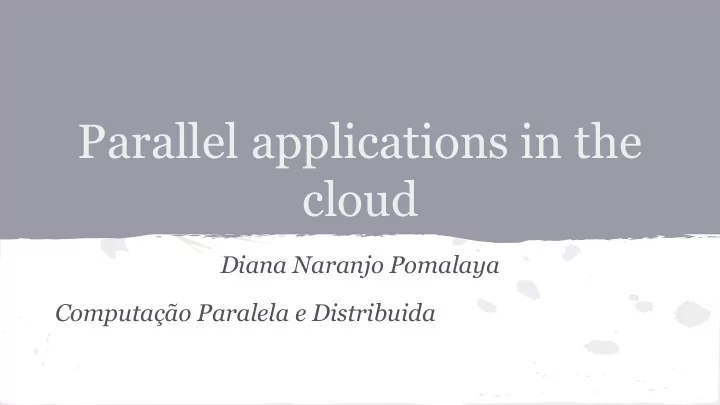

Parallel applications in the cloud Diana Naranjo Pomalaya Computação Paralela e Distribuida
Agenda ● Introduction ● MapReduce ● Solutions ○ Haloop ○ iMapReduce ○ Pig
Global Data Center Traffic Source: Cisco Global Cloud Index, 2013–2018
Data-intensive applications ● Industry ● Sciences ○ Web-data analysis ○ Massive-scale ○ Click-stream simulations data analysis analysis ○ Network-monitoring ○ Sensor deployments log analysis ○ High-throughput lab equipment
MapReduce Combine/ Combine Reduce Map Local Sort Merge Shuffle Combine/ Map Local Sort Combine Reduce Merge
MapReduce ○ Easy-to-use ○ Designed for Batch- programming model oriented (2 functions) computations (N-step ○ Scalability dataflows) ○ Fault-tolerance ○ Low-level abstraction ○ Load balancing (combined data sets, ○ Data locality-based primitive operations) optimization
Solutions Haloop iMapReduce Pig Loop-aware Persistent tasks High-level data scheduler manipulation Input data loaded once Caching Hadoop mechanisms execution Asynchronous execution
Haloop ● Hadoop based framework ● Supports iterative programs ● Loop-aware scheduler and Caching Mechanisms
Hadoop Master Slave Client Node Node submits jobs schedules Slave tasks Node Task Scheduler creates Slave tasks Node Slave Node Task Tracker manages tasks’ execution
Haloop Master Slave Client Node Node submits jobs schedules Slave tasks Node Loop Control Initiates map- Task reduce steps until Scheduler creates Slave termination tasks Node condition is met Slave Node Data locality Task By the means of Tracker manages tasks’ execution caching and indexing
Haloop - Loop control ● Goal: place on same physical machine map/reduce tasks that occur in different iterations but access same data ● How: ○ Keep track of data partitions processed by each task on each physical machine ○ Map new tasks to slave nodes that have alreasy processed that data partition ○ If node full, then re-assign to other node
Haloop - Caching and indexing ● Reducer input cache: useful for repeated joins against large invariant data (wastes less time in shuffling) ● Reducer output cache: reduce cost of fixpoint termination condition avaliation ● Mapper input cache: useful in k-means similar applications (input data does not vary) ● Cache reloading: if node is full, copy all required data to new assigned node
iMapReduce ● Based on Hadoop ● Framework for iterative algorithms ● Concept of persistent tasks, input data loaded to persistent tasks once and facilitates asynchronous execution of tasks within iteration
iMapReduce - Restrictions ● Map and reduce operations use Graph-based same key (one-to-one mapping) iterative algorithms ● Each iteration contains only one MapReduce job
iMapReduce - Persistent tasks ● Tasks keep alive during whole DFS DFS iteration process (dormat as Map data is parsed/processed) Job 1 Reduce Map ● Depends on available task slots DFS Job (problem with balancing load - Reduce Map strangles/leaders nodes) Job 2 . . . . . . DFS DFS
iMapReduce - Data management ● Input data becomes: static data (invariant) and state data (variant) ● State data is passed from reduce to map tasks through socket connections ● Static data is partitioned with the same hash function used to shuffle state data ● Map and reduce tasks (one-to-one due to key restriction) are scheduled to same worker
iMapReduce - Asynchronous execution ● Map tasks can start execution as soon as its state data arrives ● No need to wait for other map tasks ● Fault-tolerance problem: use buffer to save results from reduce tasks (return to last iteration)
Pig ● Provides constructs that allow high-level data manipulation ● Allows employment of user-provided executables ● Compiles data-flow programs (pig latin) into sets of MapReduce jobs and coordinates its execution (Hadoop)
Pig - Compilation and execution stages Physical Logical Plan Plan (DAG) (DAG) Logical MapReduce MapReduce Hadoop Job Parser optimizer Compiler Optimizer Manager Type Ex. Filter Mapping Distributive/ Monitor check pushdown from logical algebraic (minimize to physical operations Schema amount of to map, inference data combine scanned and reduce and steps processed)
Pig - Memory Management ● Pig is implemented in JAVA ● Memory overflow situations when large bags of tuples are materialized between and inside operators ● Solution: List of bags ordered in descending order (estimated size), spill bags when threshold is reached
iMapReduce - Streaming ● User-defined functions are supported in JAVA and are synchronous ● Streaming executables allow other languages to be used (scripts/compiled binaries) ● Streaming executables are asynchronous (queues)
Pig - Performance 17 December, 2010 6 June, 2015: release 0.15.0 available Source: India Hadoop Summit - Feb, 2011
PigPen ● MapReduce language that looks and behaves like Clojure.core ● Supports unit tests and iterative development ● Used in Netflix
References ● Cisco and/or its affiliates. Cisco global cloud index: Forecast and methodology 20132018 white paper, 2014. ● Yingyi Bu, Bill Howe, Magdalena Balazinska, and Michael D. Ernst. Haloop: Efficient iterative data processing on large clusters. ● Yanfeng Zhang, Qixin Gao, Lixin Gao, and Cuirong Wang. C.: Imapreduce: a distributed computing framework for iterative computation. In In: Proceedings 8 of the 1st International Workshop on Data Intensive Computing in the Clouds (DataCloud, page 1112, 2011. ● Thilina Gunarathne, Bingjing Zhang, Tak lon Wu, and Judy Qiu. Portable parallel programming on cloud and hpc: Scientific applications of twister4azure,” presented at the portable. In Parallel Programming on Cloud and HPC: Scientific Applications of Twister4Azure, 2011. ● Jaliya Ekanayake, Xiaohong Qiu, Thilina Gunarathne, Scott Beason, and Geoffrey Fox. High performance parallel computing with cloud and cloud technologies.
Questions?
Recommend
More recommend